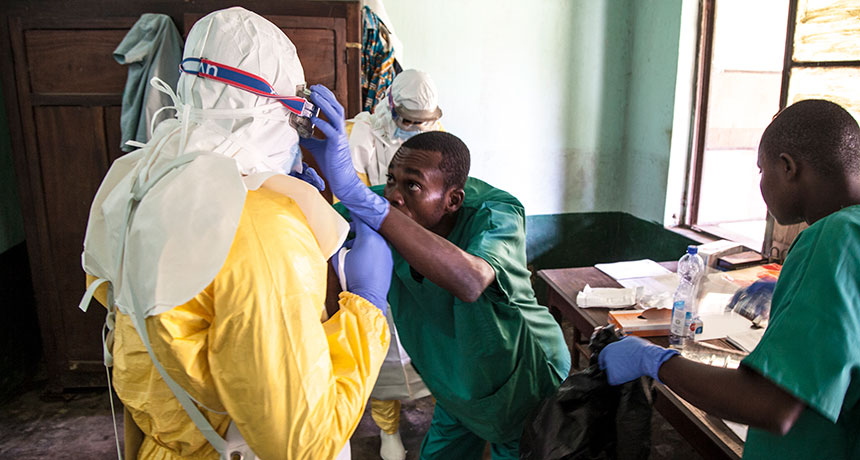What we know about the Ebola outbreak, and the vaccine that might help
The first reported case in a big city has health officials worried

SUIT UP Congo is battling its ninth outbreak of Ebola virus. Here health workers prepare to care for possible Ebola patients at Bikoro Hospital in the center of the outbreak.
Mark Naftalin/UNICEF
- More than 2 years ago
Ebola has reemerged. The virus has killed at least 25 people since early April in an ongoing outbreak in Congo. And on May 18, the World Health Organization declared a “high” public health risk in Congo, as well as a “high risk” of the disease spreading to neighboring countries, but stopped short of declaring a global public health emergency.
Most of the 43 confirmed and suspected cases reported as of May 18 have been in a rural area called Bikoro, within the same northwest Congolese province struck by the virus in 2014. (A separate, unrelated outbreak in West Africa at the same time made headlines as the deadliest in history.) And in May 2017, eight cases were reported in the nearby province of Bas Uélé.
But this year is different — for a couple of reasons. As of May 18, four cases have been confirmed in Mbandaka, a riverside city of at least 1.2 million people, raising the risk of the disease spreading. Health officials are also trying out an experimental vaccine this year in hopes of containing the outbreak. “We’ve seen what Ebola can do, but we know what needs to be done,” says WHO spokesperson Tarik Jasarevic.
Here’s what we know so far:
How did this year’s outbreak start?
Details are spotty. A report by the International Red Cross identifies the first suspected case as a policeman in a Bikoro village called Ikoko Impenge. Another 11 family members later fell ill after the policeman’s funeral, and seven of those relatives have also since died. (Because the bodies of Ebola victims remain contagious after death, funerary rituals can be a source of transmission.)
However, the investigation is still in progress, and both the WHO and local health officials say the first case hasn’t been identified. “We still don’t know exactly what started this outbreak,” says Jasarevic.
What’s the biggest worry right now?
Now that the virus has been detected in a city, more people could come into contact with it. “That means we have to scale up the response,” Jasarevic says. Both the 2014 and 2017 outbreaks were largely confined to remote, rural areas, which made them easier to contain. On May 17, the WHO confirmed the first urban case in Mbandaka. A day later, the Congolese Department of Health confirmed three more.
How have health officials responded so far?
On May 9, epidemiological teams from the WHO and Doctors Without Borders arrived in Bikoro and set up a mobile lab and a treatment center. They began tracking the spread of the virus. Supplies are also en route — including the experimental vaccine.
Just how experimental is this vaccine?
Researchers began working on vaccines after the deadly 2014 outbreak killed some 11,000 in West Africa (SN: 12/26/15, p. 33). The first batch of one experimental vaccine called rVSV-ZEBOV, manufactured by Merck pharmaceutical company, reached the Congolese capital of Kinshasa on May 16.
The vaccine performed well in a 2016 field trial involving 5,837 people in Guinea (SN Online: 12/22/16). But the drug must be kept at a temperature between –60° Celsius and –80°C, making transportation and storage tricky.
The vaccine still lacks formal approval, but was cleared by both the WHO and Congolese officials for “compassionate use” in response to the most recent outbreak. Vaccination could begin in the next few days, and would mark the first time a vaccine has been used in response to an Ebola outbreak in the field.
In the trial, the WHO used a “ring vaccination” strategy, immunizing family and immediate contacts of victims immediately, to help stave off the virus’ spread. A similar approach will likely be used in Congo.
Is this a new strain of Ebola?
No. Test results show that Zaire ebolavirus, which caused the 2014 and 2017 illnesses, is also responsible for this year’s outbreak, Jasarevic says. There could be some small genetic differences between versions from different years; only further genetic testing could reveal if that’s the case here.
But the good news is that the rVSV-ZEBOV vaccine targets a protein on the surface of the Zaire strain of Ebola, so it should work against the virus in the current outbreak.







